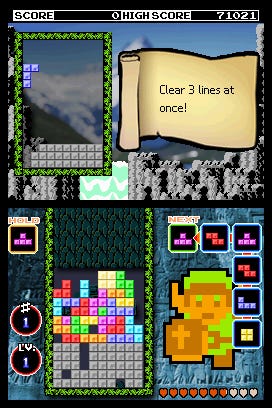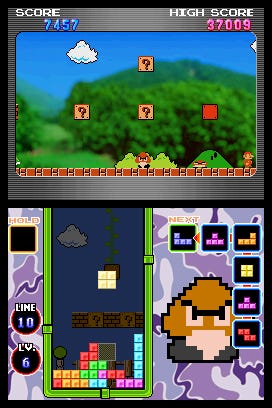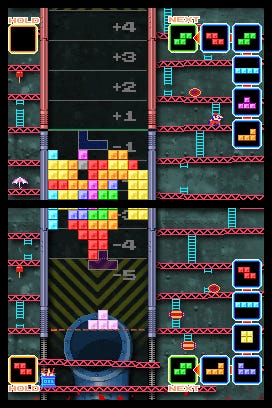If ever a game muddled with time, it’s Tetris. I’m not just talking about the idle hours that somehow disappear as you play, but the way that the whole game sits within the flow of time itself. Tetris’ 40th anniversary is upon us this summer (the exact date is a little woolly, with the Tetris Company putting it in June, but still announcing official celebrations this weekend), and that feels weird from both temporal directions. In one way, the game feels so fresh, so cleanly designed, it can surely only be a few weeks old at most? In the other way, hasn’t a design this beautiful been with us since the first galaxies were forming? Wasn’t it there in the code of the universe waiting to be unearthed? It’s all very weird.
To celebrate the 40th birthday – and finally, a 40th birthday I feel like celebrating! – I initially thought I’d go back to Tetris Effect, that beautiful cosmic riff on falling blocks that takes the Tetris basics and builds a luminous cathedral out of them. Tetris Effect is that rare reimagining of a classic that feels practically definitive. If you’re going to play Tetris today, I want to say – okay, first play the OG Game Boy Tetris because of history and the feel of those concrete long blocks on that gorgeous green screen. But then play Tetris Effect. It’s properly one of the greatest games ever, a rocket aimed right at the heart.
Cathedrals are nice, but the more I thought about it, the more I realised I should write about a different version of Tetris – and another version that seems as restless and experimental when it comes to the basic design. So a belated happy 40th, Tetris: let’s take a moment to remember Tetris DS, released on Nintendo’s handheld back in – jeepers! – 2006. If Tetris Effect is the Tetris cathedral, this is the Tetris laboratory. Come on in. It’s weird and brilliant down here.
Tetris DS had six different versions of Tetris back in the day. Six! This felt absolutely wild. Six spins on Tetris, including a rendition of classic Tetris which was so densely, overwhelmingly Mario themed that it felt like the Mushroom Kingdom had thrown up all over it.
I’m being crude, but so, in its way, is the classic mode of Tetris DS. As you play classic Tetris here, Mario moves along the screen at the top, jumping on Goombas and knocking Koopas about. It’s the blocks and sprites you recognise, but the backgrounds are weird and sort of Windows XP screensavery. It all clashes gorgeously, as it should, because there’s Tetris below, Mario above, and all manner of warping sprites and chiptune fan service exploding everywhere else.

A quick counterpoint: while the stylings are OTT, the version of Tetris on offer in Classic Tetris is rather refined. Infinite spin? Check. Hard- and soft-drops? Check check. Markers for where your pieces are going to land? You got it. This is Tetris curated by Niles Crane. It was a class act all along!
Now to the variants. Touch is always the first place people go, and they absolutely should not, because as much as I love Tetris DS – and in a weird way, it may be my personal favourite of all Tetris games, and that’s not for a moment suggesting it’s the best – the solo Touch mode is just too weird. It’s not the design itself, which is rather clever. You are faces with a stack of pieces and you must pull them around, left and right, and rotate them, to make lines, with new pieces teetering above. It’s Tetris as luggage stack, and that’s fine. The problem is that the art style takes that approach to Tetris which ignores the individual blocks making up the shapes of the tetrominoes and instead just gives you shapes. No seams or indentations. I had a girlfriend once who could not stand the feel of unglazed pottery. It made her skin prickle. I feel the same about the tetrominoes in Touch. (There’s another Touch mode for two players, BTW – let us not speak of it.)
Mission mode next: Mission mode is Zelda themed and very lovely. You have to play Tetris, but rather than going for a high score you’re completing a range of quests. Clear two lines. Clear four lines. Clear lines using the 2X2. Lovely stuff and I think Link would approve. Link is a good boy, and here he is doing what he’s told rather than going for individual glory. This is harmony achieved between theme and mechanics.
Onwards! Push mode is probably Tetris DS’ moment of genius. But it’s very weird genius, which makes it even better. Two players, one at either end of the well, and they throw Tetris pieces into the middle of the well and play a sort of inverted tug of war. They’re building something and trying to use it to push the other player back into oblivion. With the grid markers, Push mode has always felt like American Football to me – American Football as the tactical game about moving forward and stealing as much territory as you can.

It’s clever, but it’s also, like I said, quite weird. And it’s weird because while you push back and forth and chuck in tetrominoes you can’t ignore that there’s something growing at the centre of the playing field. Without meaning to, both players are building something. A Tetris lump. A wordless, nameless Tetris Object. And this brings us to Tetris DS’ Metroid-themed experiment whose name I can never remember. Oh, it’s Catch mode!
Catch mode is properly, properly weird, in keeping with its Metroid coating. You’re moving through Samus World, and as you move, you collect stray tetrominoes, adding them to a growing bait ball of blocks at the middle of the screen. The Tetris Object is back, but now there’s really no avoiding it. Catch is clever stuff again: you build this lump of block, and when it hits a certain size it explodes and then you keep going. Miss pieces and fail to add them to the block and you lose energy. Clever, but also unsettling. This thing will not stop growing. You rotate it and its shape just gets weirder and weirder. How incredibly Metroid.
The last mode is Puzzle mode, which basically turns Tetris into a newspaper crossword page game. You’re presented with a semi-complete Tetris playing field and you have a selection of tetrominoes to rotate and place in the proper sequence to clear all the blocks. There are dozens and dozens of these puzzles. Playing the game on and off since 2006, I don’t think I’ve ever gotten to the end of them. It’s cerebral and soothing and everything Tetris inherently is once you strip out the fact that in the core game things get faster and faster until you’re dead.

I say that’s the last mode, but that’s not quite true. Back in the day, using a weird Nintendo wi-fi gadget that plugged into a laptop, you could go online and play Tetris with people around the world, competitively. I say competitively: the people I played against were competing. I was merely fodder for their brilliance. Looking back, though, this odd mode that required an additional doodad and delivered nothing but crushing defeat at the hands of Japanese Tetris masters may have also provided all my favourite memories of this weird, infuriating, brilliant game.
For one thing, I couldn’t always connect, so once I could, things felt extra special. For another, it was the early days of playing online for me, so it felt like I’d been given a sort of Ham Radio that only spoke Tetris. I was dialled into the Tetris sphere, communicating with that eternal long block that lurked at the bright centre of the Milky Way. I spent an evening last week, knowing the 40th was coming, looking through the loft in case I could find that weird wi-fi dongle, with the hope that if I could get it working, I might be able to go back to that early 2000s word of Japanese Tetris greats and play a few more games with them, the same way a radio and a solar storm allows Jim Caviezel to talk to his dead old dad Dennis Quaid in the underrated banger Frequency.
I couldn’t find it, but then I read online that the wi-fi gadget doesn’t work anymore. So maybe now Tetris DS is actually the perfect package: six versions of Tetris! Six! And one special online world that is forever out of reach. Happy birthday, Tetris. What a beautiful, endlessly mystifying game you are.
